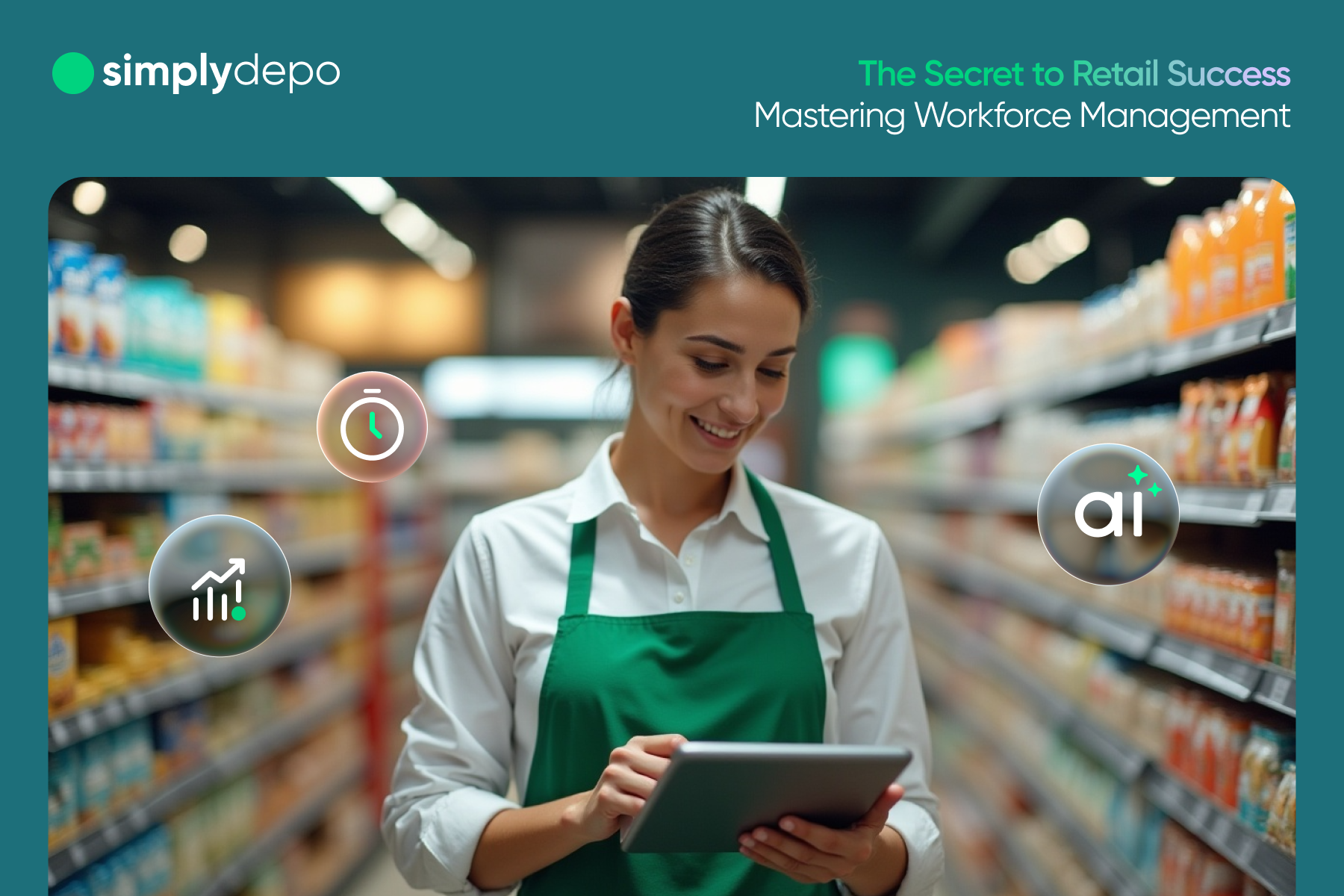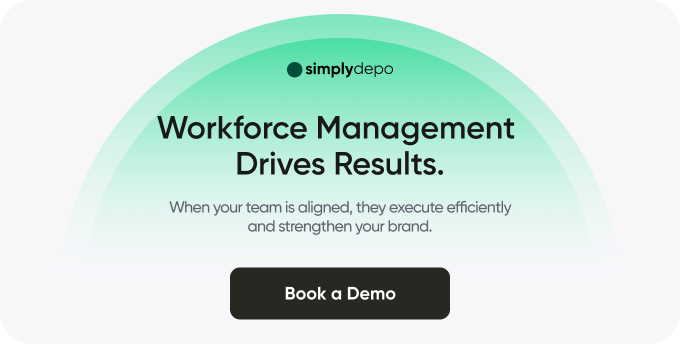Retail workforce management is the process of planning, assigning, and optimizing retail staff tasks using real-time data, AI, and collaboration tools to improve store execution and sales.
We talk a lot about inventory, pricing, and promotions in retail. But behind every stocked shelf, every smiling customer, and every sale is something less glamorous but far more powerful.
Welcome to the age of retail workforce management – the secret ingredient that separates thriving retail operations from just getting by. Whether you’re running a regional distribution network or a high-traffic store, your team is your engine. And if that engine isn’t optimized, your whole operation suffers.
This article will explore how workforce management – powered by smart systems, clear processes, and data-driven leadership – is changing retail success in 2025.
It’s Not Just Scheduling. It’s a Strategy.
Workforce management is often seen as a back-office function limited to staff schedules and payroll. But that’s a narrow view.
In today’s competitive landscape, workforce management includes:
- Forecasting labor needs based on demand
- Tracking task completion and field rep performance
- Managing compliance and role clarity
- Empowering front-line teams with tools and feedback
- Aligning people with priorities in real time
Done well it leads to higher efficiency, lower turnover, better store execution and stronger sales.
What Happens When You Get It Wrong
Poor workforce management doesn’t just slow down operations—it affects the bottom line.
Common symptoms include:
- Missed store visits or delays in retail execution
- High rep churn due to unclear expectations
- Inconsistent customer service
- Bottlenecks in promotions or planogram resets
- Disconnected communication between HQ and field teams
The ripple effect? Products sit unsold, promotions underperform and customers go to competitors.
Shifting the Lens: Workforce Management as a Growth Lever
Retailers and distributors who treat workforce management as a strategic function, not a support task, unlock a massive opportunity.
When your reps know where to go, what to do and why it matters—they execute faster, spot issues earlier and elevate the brand in every interaction.
Think of it as a cycle:
- Plan: Forecast the workload based on real store data
- Assign: Allocate the right reps to the right routes and stores
- Execute: Enable tasks, photo uploads and checklists in the field
- Review: Use performance data to coach and optimise
- Repeat: Continuously improve based on what’s workingAnd this isn’t a future ideal—it’s already happening.
Traditional workforce management vs AI-driven workforce management
| Feature | Traditional Workforce Management | Modern AI-Driven Workforce Management |
| Scheduling | Manual spreadsheets | Automated, AI-optimized routes |
| Communication | Emails, calls | Mobile apps with live updates |
| Performance Tracking | Monthly reports | Real-time dashboards |
SimplyDepo in Action: People-Powered Retail Execution
SimplyDepo isn’t just about data—it’s built to support the people executing in retail.
Case Example: ICalm
ICalm’s merchandising team was using spreadsheets and WhatsApp threads to manage over 100 store visits per week. After switching to SimplyDepo, they centralised all workforce planning and field reporting into one mobile system.
Outcomes:
- Field visit compliance improved by 42% in three months
- Managers got real-time visibility into rep performance
- Reps reported less stress and clearer expectations
“It’s not just that we do more visits—it’s that we know which visits matter most. That’s the difference.” – ICalm Field Team Lead
What Modern Retail Workforce Management Looks Like
Forget paper schedules and Excel-based tracking. Here’s what best-in-class workforce management includes:
✅ Real-Time Task Visibility
Assign and update tasks instantly, with real-time confirmation and photo uploads.
✅ Smart Route Planning
Combine route efficiency with store priority—ensure high-value locations get the right attention.
✅ Field Team Empowerment
Reps have a mobile app to check schedules, upload evidence, report issues and communicate directly with managers.
✅ Performance Analytics
Track KPIs like task completion rate, visit duration, sales uplift post-visit and more.
✅ Collaboration Tools
Centralise updates, changes and team notes in one place—no more back-and-forth emails.
It’s About People, Not Just Processes
While automation and AI improve scheduling and routing, your workforce is still human. And managing them well requires more than dashboards.
Strong retail workforce management means:
- Setting clear expectations
- Celebrating wins and learning from mistakes
- Giving teams autonomy but with accountability
- Creating feedback loops between store floor and HQ
- Supporting career development and retention
The best systems don’t just track reps—they support them.
The Human Cost of Poor Management
Here’s what bad workforce management feels like to the people doing the work:
- Confusion: “Where am I going tomorrow? What am I supposed to do?”
- Frustration: “Why did someone else get my route?”
- Disconnection: “Nobody reads my reports. Why bother?”* Burnout: “There’s no time between visits, and expectations keep changing.”
These feelings translate directly into missed visits, underperformance, and turnover.
Managers Need Better Tools
Good managers make or break execution. But even the best leaders struggle if they’re managing 10 reps across 50 stores with no visibility.
With SimplyDepo, managers can:
- See daily visit execution live
- Change schedules based on urgency or territory
- Coach underperforming reps with specific examples
- Recognize strong performers with real-time data
And because it’s mobile, they can lead from anywhere.
Who Owns Workforce Management?
Traditionally, HR handled staffing, Ops handled scheduling, and Sales pushed field targets. But today, the most successful retailers assign cross-functional ownership of workforce management.
At minimum, the following roles must align:
- Field Operations Leads: Ensure coverage and execution
- Sales Managers: Drive revenue-focused task prioritization
- HR or People Teams: Support training, feedback and retention
- IT or Digital Teams: Enable the tech stack that connects them
This alignment turns workforce management from a task list into a strategic advantage.
The Future: AI + Empathy
As AI takes over the retail landscape, workforce management will move from reactive planning to predictive guidance.
Imagine:
- Reps are getting suggested routes based on store needs and sales data
- AI flagging high-burnout patterns before they lead to turnover
- Real-time language translation for multinational field teams
- Dynamic task lists that adapt to weather, traffic or in-store conditions
But none of that works without human-centered leadership. The best tech will support, not replace, the relationships that build great retail teams.
Key Takeaways: Retail Workforce Management
Definition
Retail workforce management is the strategic planning, assignment, and optimization of retail and field team activities using real-time data, AI, and collaborative tools to improve store execution, efficiency, and sales.
Business Impact
- Improves task execution speed and accuracy
- Reduces employee turnover through clear expectations and role alignment
- Enhances customer experience by ensuring the right staff in the right place at the right time
- Boosts promotional ROI and planogram compliance
Core Features of Retail Workforce Management
- Real-time task visibility with instant updates and confirmations
- AI-driven route optimization for efficient store coverage
- Performance analytics to monitor KPIs such as completion rates and sales lift
- Mobile field tools for photo uploads, reporting, and communication
FAQs Retail Workforce Management
- What is workforce management?
Planning, assigning, tracking and optimising the work of front-line retail employees and field teams to get execution and customer satisfaction. - What are the benefits?
Productivity, lower labour costs, better task execution and higher employee engagement. - How does SimplyDepo help with workforce management?
Mobile task tracking, route planning, performance dashboards and real-time field visibility all in one place. - Who owns workforce management?
It should be shared across field ops, HR, sales and IT – requires cross-functional alignment to work. - Is workforce management only for big teams?
No. Teams of 3-5 field reps can benefit from better task tracking, mobile visibility and smarter scheduling. - How does workforce management improve retail store execution?
By using real-time scheduling, task tracking, and performance monitoring, managers can ensure planograms are followed, promotions are launched on time, and customer service is consistently delivered. - What KPIs should retail managers track in workforce management?
Important KPIs include task completion rates, visit compliance, sales uplift post-visit, labor cost per sale, employee turnover, and customer satisfaction scores. - How does workforce management reduce employee turnover in retail?
Clear schedules, fair workload distribution, recognition programs, and open communication channels help employees feel valued and supported, reducing stress and burnout. - Can workforce management improve promotional ROI in retail?
Yes. By aligning labor schedules with high-traffic periods and ensuring promotions are executed correctly, retailers can maximize the impact and sales return from marketing campaigns. - What challenges does poor retail workforce management cause?
Common issues include missed store visits, inconsistent customer service, delayed promotions, planogram non-compliance, and higher employee turnover.
Boost Sales.
Cut Manual Work.
Streamline ordering, routing, and retail execution — while giving every rep the tools to grow accounts faster.
-
+15h
Save weekly
per rep -
93%
Increase
buyer retention -
24%
Increase
in retail sales

Error: Contact form not found.













